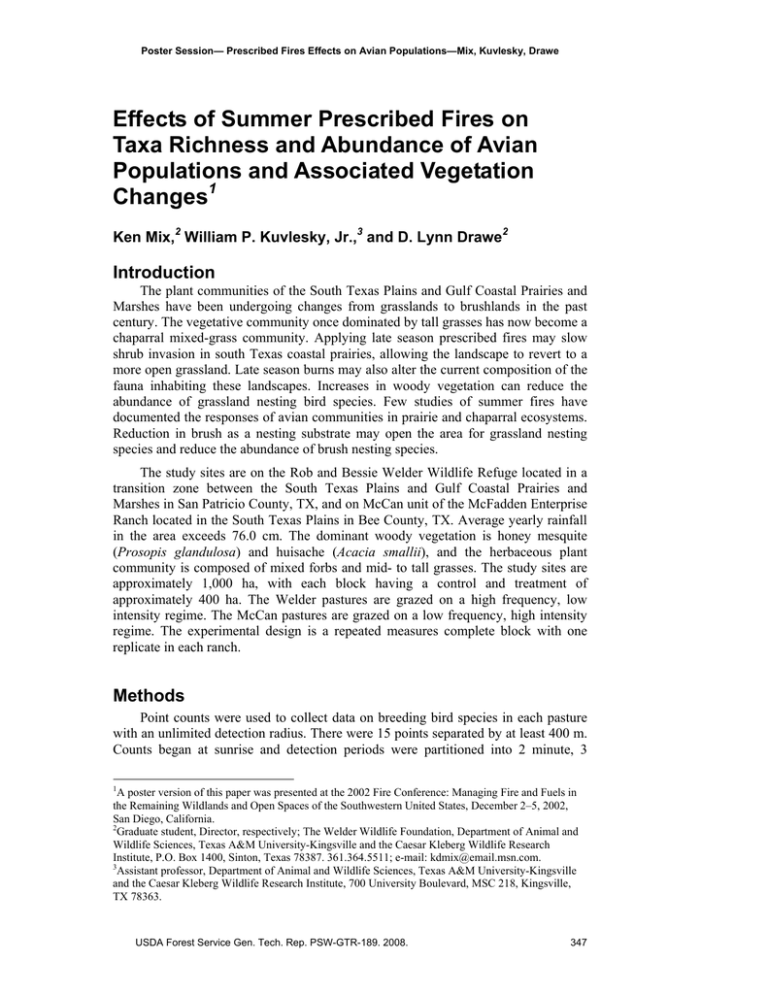Effects of Summer Prescribed Fires on Populations and Associated Vegetation
advertisement

Poster Session— Prescribed Fires Effects on Avian Populations—Mix, Kuvlesky, Drawe Effects of Summer Prescribed Fires on Taxa Richness and Abundance of Avian Populations and Associated Vegetation Changes1 Ken Mix,2 William P. Kuvlesky, Jr.,3 and D. Lynn Drawe2 Introduction The plant communities of the South Texas Plains and Gulf Coastal Prairies and Marshes have been undergoing changes from grasslands to brushlands in the past century. The vegetative community once dominated by tall grasses has now become a chaparral mixed-grass community. Applying late season prescribed fires may slow shrub invasion in south Texas coastal prairies, allowing the landscape to revert to a more open grassland. Late season burns may also alter the current composition of the fauna inhabiting these landscapes. Increases in woody vegetation can reduce the abundance of grassland nesting bird species. Few studies of summer fires have documented the responses of avian communities in prairie and chaparral ecosystems. Reduction in brush as a nesting substrate may open the area for grassland nesting species and reduce the abundance of brush nesting species. The study sites are on the Rob and Bessie Welder Wildlife Refuge located in a transition zone between the South Texas Plains and Gulf Coastal Prairies and Marshes in San Patricio County, TX, and on McCan unit of the McFadden Enterprise Ranch located in the South Texas Plains in Bee County, TX. Average yearly rainfall in the area exceeds 76.0 cm. The dominant woody vegetation is honey mesquite (Prosopis glandulosa) and huisache (Acacia smallii), and the herbaceous plant community is composed of mixed forbs and mid- to tall grasses. The study sites are approximately 1,000 ha, with each block having a control and treatment of approximately 400 ha. The Welder pastures are grazed on a high frequency, low intensity regime. The McCan pastures are grazed on a low frequency, high intensity regime. The experimental design is a repeated measures complete block with one replicate in each ranch. Methods Point counts were used to collect data on breeding bird species in each pasture with an unlimited detection radius. There were 15 points separated by at least 400 m. Counts began at sunrise and detection periods were partitioned into 2 minute, 3 1 A poster version of this paper was presented at the 2002 Fire Conference: Managing Fire and Fuels in the Remaining Wildlands and Open Spaces of the Southwestern United States, December 2–5, 2002, San Diego, California. 2 Graduate student, Director, respectively; The Welder Wildlife Foundation, Department of Animal and Wildlife Sciences, Texas A&M University-Kingsville and the Caesar Kleberg Wildlife Research Institute, P.O. Box 1400, Sinton, Texas 78387. 361.364.5511; e-mail: kdmix@email.msn.com. 3 Assistant professor, Department of Animal and Wildlife Sciences, Texas A&M University-Kingsville and the Caesar Kleberg Wildlife Research Institute, 700 University Boulevard, MSC 218, Kingsville, TX 78363. USDA Forest Service Gen. Tech. Rep. PSW-GTR-189. 2008. 347 Poster Session—Prescribed Fires Effects on Avian Populations—Mix, Kuvlesky, Drawe minute, and 2 minute intervals. Counts were conducted three times from May 1 until June 21, 2001 and 2002. Ten vegetation transects were selected from the 15 avian points. Vegetation data were categorized as woody shrubs, tress, forbs, and grasses. A 30 m line intercept was used to collect percent cover of woody and herbaceous vegetation. A vertical pole was used to collect visual obscurity data at the 20, 40, 60, 80, and 100 ft intervals and measured from a distance of 4 m. The data were collected in June and July, 2001 and 2002. Results ANOVA (analysis of variance) was used to analyze avian population and vegetation changes between pastures within a block. Changes in vegetation occurred in the treatment pastures of both blocks between 2001 and 2002 with significance set at p=0.10. In Block 1 visual obscurity (VO) changed significantly in the treatment pasture after the fire in these intervals: 0 to 1 m (p<0.0001), 1 to 2 m (p=0.0669), and total VO (p<0.0001). Percent woody cover was significantly different after the burn, reduced from 28.12 percent to 11.25 percent (p=0.0249). In Block 2 VO was significantly different in these intervals: 0-1 m (p=0.0060). 1 to 2 m (p=0.0023), 2 to 3 m (p=0.0599), and total VO (p=0.0018). Percent woody cover was significantly different after the burn, reduced from 45.55 percent to 16.27 percent (p<0.0001). No changes in the nesting species have been linked to changes in nesting substrate. Most avian species showed little or no change in population in the treatment pastures from 2001 to 2002. The following species significantly changed in population in treatment pastures: Block 1, northern mockingbird (NOMO) (p=0.0993) and painted bunting (PABU) (p=0.0292); Block 2, Cassin’s sparrow (CASP) (p=0.0198), northern cardinal (NOMO) (p=0.0051), olive sparrow (OLSP) (p=0.0517), and PABU (p=0.0248). Discussion Overall changes in avian populations were not significant. Though a few species did exhibit significant changes in population, no attribution can be made to changes brought about by summer fires, particularly since two brush nesting species exhibited positive changes in population in a treated pasture: PABU, and NOCA in Block 2. Changes in percent woody cover do not appear to affect the avian population. Though there were reductions in percent woody and visual obscurity caused by the fire, it may be necessary to reduce each of these below a certain threshold to effect changes in the avian populations. 348 USDA Forest Service Gen. Tech. Rep. PSW-GTR-189. 2008.






